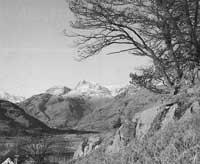The city pollutes the mountain
1994/02/01 Elhuyar Zientzia Iturria: Elhuyar aldizkaria
Since 1978 scientists (and non-scientists) have been concerned about the reduction of the ozone layer in the stratosphere (between 20 and 45 kilometers of altitude). Annual measurements are made and measures have been taken to alleviate the problem (prohibition of products with CFCs, for example).
However, scientists also begin to worry about the presence of ozone in the troposphere (between 10 and 15 kilometers of altitude), even though nothing is heard in newspapers and magazines. We know that in the stratosphere ozone protects us from the ultraviolet rays of the sun, but in the troposphere ozone can be harmful to our health. This is because it causes eye and pharynx irritation and respiratory problems. In addition, plants are affected by leaf necrosis.

Ozone is formed by the photooxidation of the mixture of some chemical compounds in the troposphere. Methane (CH4), carbon monoxide (CO) and volatile organic compounds (terpene, isoprene, etc.) They are photooxidized in nitrogen oxides. For this reaction to occur, first of all, there must be a level of nitrogen oxide concentration in the air, which means burning fossil fuels (in vehicles, thermal power plants, etc. ).
When the concentration of nitrogen oxides is between several tens of ppt (parts per trillion) and ppb parts (parts per trillion), the oxidation of CO, CH4 and volatile organic compounds by reactions produces ozone. However, when the concentration of nitrogen oxides is higher than about ppb, oxidation reactions slow down and inhibit the ozone production of nitrogen oxides. Therefore, the highest concentration of ozone in the polluted atmosphere is not in the area of greatest contamination (where the concentration of nitrogen oxides is higher), but tens of kilometers from the source of pollution. In Paris, for example, the highest concentration of ozone in the city center and southwest is towards Rambouillet (sometimes with concentrations above 150 ppb, six times higher than Paris).
The concentration of ozone in the Troposphere has multiplied by four in the northern hemisphere and has doubled in the south. On the planet as a whole, the concentration increases by 1% or 2% annually, so drastic measures must be taken to maintain this type of pollution.

Gai honi buruzko eduki gehiago
Elhuyarrek garatutako teknologia




